

Billy Clanton. Early life[edit] Born in Hamilton County, Texas, William Harrison "Billy" Clanton was one of seven children of Newman Haynes Clanton, (1816–1881) and his wife Mariah Sexton (Kelso) Clanton: John, Ike Clanton, Alonzo, Mary, and Ester.
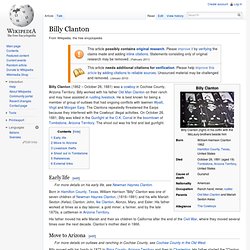
His father worked at times as a day laborer, a gold miner, a farmer, and by the late 1870s, a cattleman in Arizona Territory. His father moved his wife Mariah and their six children to California after the end of the Civil War, where they moved several times over the next decade. Clanton's mother died in 1866. Move to Arizona[edit] Billy Clanton and his brother Ike often went into Tombstone on weekends, and Billy did business in Tombstone associated with the ranch, alongside the two McLaury brothers.
Livestock thefts[edit] A few days after Wyatt Earp's arrival in Tombstone in December 1879, one of his prized horses was stolen. Belle Starr. Myra Maybelle Shirley Reed Starr (February 5, 1848 – February 3, 1889), better known as Belle Starr, was a notorious American outlaw.

Early life[edit] Belle Starr was born as Myra Maybelle Shirley on her father's farm near Carthage, Missouri. She was known as May to her family. Ike Clanton. Ike Clanton filed murder charges against the Earps but after a 30-day preliminary hearing, Justice Wells Spicer ruled that the lawmen had acted within their lawful duty.

Ike Clanton was implicated in the attempted assassination of Virgil Earp on December 30, 1881, but other Cowboys provided an alibi and he was released. Clanton was killed attempting to avoid arrest six years later when he was shot by a lawman seeking to arrest him for cattle-rustling. Early life[edit] Doc Holliday. John Henry "Doc" Holliday (August 14, 1851 – November 8, 1887) was an American gambler, gunfighter, and dentist of the American Old West who is usually remembered for his friendship with Wyatt Earp and his involvement in the Gunfight at the O.K.
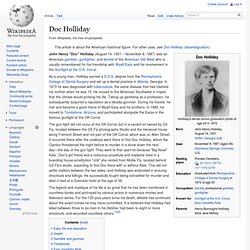
Corral. As a young man, Holliday earned a D.D.S. degree from the Pennsylvania College of Dental Surgery and set up a dental practice in Atlanta, Georgia. In 1873 he was diagnosed with tuberculosis, the same disease that had claimed his mother when he was 15. He moved to the American Southwest in hopes that the climate would prolong his life. Taking up gambling as a profession, he subsequently acquired a reputation as a deadly gunman. Kit Carson. Christopher Houston Carson (December 24, 1809[1] – May 23, 1868) — known as Kit Carson — was an American frontiersman and Indian fighter.

Carson left home in rural present-day Missouri at age 16 and became a mountain man and trapper in the West.[2] Carson explored the west to California, and north through the Rocky Mountains. He lived among and married into the Arapaho and Cheyenne tribes. He was hired by John C. Fremont as a guide, and led 'the Pathfinder' through much of California, Oregon and the Great Basin area. He achieved national fame through Fremont's accounts of his expeditions. American Old West. The Whig Party. Established in 1834, the Whig Party was a reaction to the authoritarian policies of Andrew Jackson.
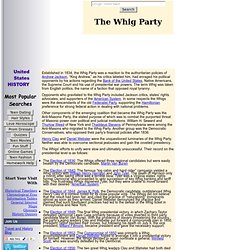
“King Andrew,” as his critics labeled him, had enraged his political opponents by his actions regarding the Bank of the United States, Native Americans, the Supreme Court and his use of presidential war powers. The Civil War at a Glance. Return to Publications.USA.gov Resource Topics for Parklands National Park Service U.S.
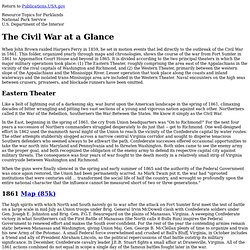
Al Swearengen. Ellis Albert "Al" Swearengen (b.
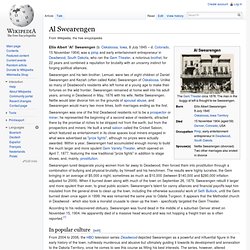
Seth Bullock. Seth Bullock (July 23, 1849 – September 23, 1919) was a Canadian/American Western sheriff, hardware store owner and U.S.

Marshal. Early life[edit] Mexican–American War. The Mexican–American War, also known as the Mexican War, the U.S.

–Mexican War or the Invasion of Mexico, was an armed conflict between the United States and the Centralist Republic of Mexico (which became the Second Federal Republic of Mexico during the war) from 1846 to 1848. Pancho Villa. José Doroteo Arango Arámbula (5 June 1878 – 20 July 1923) – better known by his pseudonym Francisco Villa or his nickname Pancho Villa – was one of the most prominent Mexican Revolutionary generals. Villa and his supporters seized hacienda land for distribution to peasants and soldiers. He robbed and commandeered trains and, like the other revolutionary generals, printed fiat money to pay for his cause. Villa's men and supporters became known as Villistas during the revolution from 1910 to roughly 1920.
Early life[edit] Billy the Kid. William H. Bonney (born William Henry McCarty, Jr. c. November 23, 1859[1] – c. July 14, 1881), better known as Billy the Kid and also known as Henry Antrim, was a 19th-century Irish American gunman who participated in the Lincoln County War and became a frontier outlaw in the American Old West. According to legend, he killed 21 men,[2] but it is generally believed that he killed between four and nine.[2] He killed his first man in 1877 at the age of 9, although he could have been as old as 12.[1][3]
Parley P. Pratt. Jesse James. Jesse Woodson James (September 5, 1847 – April 3, 1882) was an American outlaw, gang leader, bank robber, train robber, and murderer from the state of Missouri and the most famous member of the James-Younger Gang. Already a celebrity when he was alive, he became a legendary figure of the Wild West after his death. Some recent scholars place him in the context of regional insurgencies of ex-Confederates following the American Civil War rather than a manifestation of frontier lawlessness or alleged economic justice.[1] Jesse and his brother Frank James were Confederate guerrillas during the Civil War. They were accused of participating in atrocities committed against Union soldiers.
Morgan Earp. Wyatt Earp. Manifest Destiny. In the 19th century, Manifest Destiny was the widely held belief in the United States that American settlers were destined to expand throughout the continent. Historians have for the most part agreed that there are three basic themes to Manifest Destiny: William Brocius. Time in Tombstone[edit] Brocius arrived from either Texas or Missouri about 1878 and went briefly to the San Carlos Reservation with a herd of cattle, before arriving in the Arizona Territory. Brigham Young. Wild Bill Hickok. Joseph Smith, Jr. The Church of Jesus Christ of Latter-day Saints. History[edit] The history of the LDS Church is typically divided into three broad time periods: (1) the early history during the lifetime of Joseph Smith, which is in common with all Latter Day Saint movement churches; (2) a pioneer era under the leadership of Brigham Young and his 19th-century successors; and (3) a modern era beginning around the turn of the 20th century as Utah achieved statehood.
Calamity Jane. Martha Jane Canary (May 1, 1852 – August 1, 1903 age 51), better known as Calamity Jane, was an American frontierswoman, and professional scout known for her claim of being an acquaintance of Wild Bill Hickok, but also for having gained fame fighting Indians. She is said to have also exhibited kindness and compassion, especially to the sick and needy.
This contrast helped to make her a famous frontier figure.[1] Andrew Johnson. Lewis and Clark Expedition. First Transcontinental Railroad - Central Pacific Railroad Photographic History Museum. Federalist Party. Buffalo Bill. George Armstrong Custer. Gunfight At The OK Corral - Tombstone - Wyatt Earp, Doc Holliday - Ike Clanton.